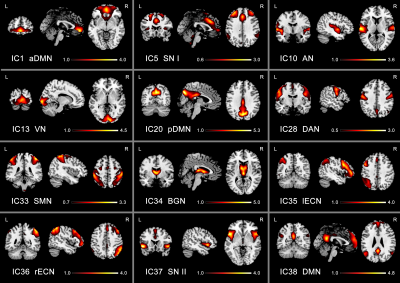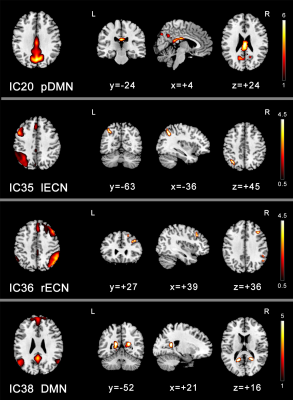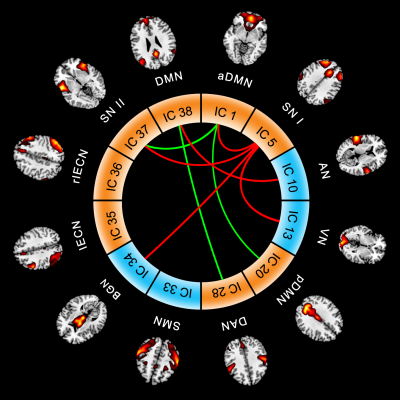1933
Altered resting-state network connectivity in patients with presbycusis
fei gao1, fuxin ren1, weibo chen2, and muwei li3
1Shandong Medical Imaging Research Institute, Shandong University, jinan, China, 2Philips Healthcare, shanghai, China, 3Vanderbilt University Institute of Imaging Science, Nashville, TN, United States
1Shandong Medical Imaging Research Institute, Shandong University, jinan, China, 2Philips Healthcare, shanghai, China, 3Vanderbilt University Institute of Imaging Science, Nashville, TN, United States
Synopsis
Presbycusis (PC) is a gradually progressive bilateral symmetrical sensory-neural hearing loss, characterized by hearing loss at high frequencies. As the most common sensory deficit in older adults, hearing deprivation was proved to be the independent influencing factor of dementia. However, the exact pathophysiological mechanism of PC and its relationship with cognitive impairment is largely unknown. In this study, therefore, we applied an ICA-based resting-state networks (RSNs) analysis to examine changes in functional connectivity of intra- and inter-network in patients with PC. Then, we explore the relationship between these abnormal functional connectivity and cognitive impairments in PC patients.
Purpose
Presbycusis (PC) is a gradually progressive bilateral symmetrical sensory-neural hearing loss, characterized by hearing loss at high frequencies, degradation in speech understanding and speech perception difficulties in noisy environments. As the most common sensory deficit in older adults, hearing deprivation was proved to be the independent influencing factor of dementia. However, the exact pathophysiological mechanism of PC and its relationship with cognitive impairment is largely unknown. In this study, therefore, we applied an ICA-based resting-state networks (RSNs) analysis to examine changes in functional connectivity of intra- and inter-network in patients with PC. Then, we explore the relationship between these abnormal functional connectivity and cognitive impairments in PC patients.Material and Methods
Fifty one presbycusis patients and the same number of normal hearing controls with well-matched age, sex and education-levels participated in this experiment (PC group, 28 males/23 females, mean age, 65.16 ± 2.43 years, NH group, 21 males/30 females, mean age, 64.67 ± 1.67 years). All participants were examined on a 3.0-Tesla MR (Philips Achieva TX, Best, Netherlands) using an eight-channel phased-array head coil. Functional images were acquired axially using a gradient echo-planar imaging sequence and Functional data preprocessing was conducted with the Data Processing & Analysis for Brain Imaging V2.3 (DPABI2) toolbox. Group ICA was carried out by using the Group ICA of fMRI Toolbox (GIFT) software. A battery of neuropsychological tests was performed in all participants in a fixed order.Results
A total of 40 components were estimated by the ICA. Twelve of these components coincided with RSNs described in previous studies. Compared with controls, PC patients showed significantly decreased network connectivity within the default mode network (DMN), left executive control network (lECN) and right executive control network (rECN). Moreover, PC patients exhibited decreased internetwork connectivity between the DMN and auditory network (AN) and between DMN and anterior salience network (SN) and between SNI and SNII and between SN and visual network (VN), as well as increased internetwork connectivity between the DMN and dorsal attention network (DAN) and between anterior DMN and posterior DMN. Moreover, the internetwork connectivity between DMN and SN showed significantly positive correlation with pure tone average (PTA). The internetwork connectivity between AN and DMN showed significantly positive correlation with auditory verbal learning test (AVLT).Conclusion
This study observed large scale reorganization at the level of the functional network in PC patients. Specifically, the internetwork connectivity between auditory network and cognition-related network decreased, while the internetwork connectivity of cognition-related network increased. Moreover, these functional abnormalities were correlated with cognitive impairment in patients with PC. Based on these findings, we argue that the onset of PC seems to trigger its own cascade of conditions, including a need for increased cognitive resources during speech comprehension, which might lead to auditory and cognition-related functional network reorganization.Acknowledgements
This work was supported by the National Natural Science Foundation of China for Young Scholars (No. 81601479); Taishan Scholars Project (No. tsqn201812147); China Postdoctoral Science Foundation funded project (No. 2017M621089) and Jinan Science and Technology Development Program of China (No. 201907114).References
No reference found.Figures

Fig. 1 A
total of 40 components were estimated by the independent component analysis. Twelve of these components
coincided with RSNs described in previous studies.

Fig. 2 Compared
with controls, PC patients showed significantly decreased network connectivity
within the default mode network (DMN), Left executive control network (lECN)
and right executive control network (rECN).

Fig. 3 PC
patients exhibited decreased internetwork connectivity between the DMN and auditory
network (AN) and between DMN and anterior salience network (SN) and between SNI
and SNII and between SN and visual network (VN), as well as increased internetwork
connectivity between the DMN and dorsal attention network (DAN) and between anterior
DMN and posterior DMN.